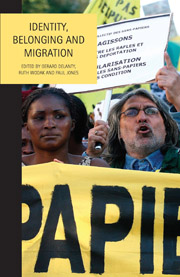Book contents
- Frontmatter
- Contents
- Acknowledgements
- List of Figures
- Notes on Contributors
- Introduction: Migration, Discrimination and Belonging in Europe
- I Theoretical Perspectives on Belonging
- II Institutional Forms of Discrimination
- 5 Racism, Anti-Racism and the Western State
- 6 What Space for Migrant Voices in European Anti-Racism?
- 7 Multiculturalization of Societies: The State and Human Rights Issues
- 8 Towards a Theory of Structural Discrimination: Cultural, Institutional and Interactional Mechanisms of the ‘European Dilemma’
- 9 On Institutional and Agentic Discrimination: Migrants and National Labour Markets
- 10 Non-Place Identity: Britain's Response to Migration in the Age of Supermodernity
- III Cases of Belonging and Exclusion
- Conclusion: Discrimination as a Modern European Legacy
- Index
8 - Towards a Theory of Structural Discrimination: Cultural, Institutional and Interactional Mechanisms of the ‘European Dilemma’
from II - Institutional Forms of Discrimination
- Frontmatter
- Contents
- Acknowledgements
- List of Figures
- Notes on Contributors
- Introduction: Migration, Discrimination and Belonging in Europe
- I Theoretical Perspectives on Belonging
- II Institutional Forms of Discrimination
- 5 Racism, Anti-Racism and the Western State
- 6 What Space for Migrant Voices in European Anti-Racism?
- 7 Multiculturalization of Societies: The State and Human Rights Issues
- 8 Towards a Theory of Structural Discrimination: Cultural, Institutional and Interactional Mechanisms of the ‘European Dilemma’
- 9 On Institutional and Agentic Discrimination: Migrants and National Labour Markets
- 10 Non-Place Identity: Britain's Response to Migration in the Age of Supermodernity
- III Cases of Belonging and Exclusion
- Conclusion: Discrimination as a Modern European Legacy
- Index
Summary
Structural discrimination consists of both institutional discrimination based upon norms, rules, regulations, procedures and defined positions that determine access to resources, and also a broader cultural discrimination based upon widely shared social paradigms and related systems of categorization that both constructs and devalues the ‘other’. In the case of institutional racism, the suggestion is that norms and other rules may operate in so-called ‘indirect’ ways; that is they are not necessarily discriminatory in intent but nevertheless may motivate exclusion of those who deviate from or challenge the norms in other ways. Crucially, institutions construct and maintain categorization systems, cultural stereotypes and attitudes that frame discriminatory ways irrespective of the intentions, personal attitudes, or beliefs of the individuals involved. In any given institution there are established organizing principles, rules and regulations, procedures, role definitions and so on, which discriminate against individuals and groups that do not ‘belong’ to majority society. Such frameworks are reflected in shared cultural elements in society such as established and legitimized category systems, concepts, stereotypes, judgment principles, generalized strategies, and societal norms that of course also cut across institutions. These are ‘societal in character’. For present purposes, an analytical distinction is made between two general institutional forms of discrimination, which can both be investigated and analysed using the tools of institutional case studies. Firstly, structural discrimination (institutional and cultural forms of discrimination) entails the automatic operation of rules and procedures – including informal ways of doing things – in ways that disadvantage migrant groups.
- Type
- Chapter
- Information
- Identity, Belonging and Migration , pp. 152 - 172Publisher: Liverpool University PressPrint publication year: 2011
- 3
- Cited by

